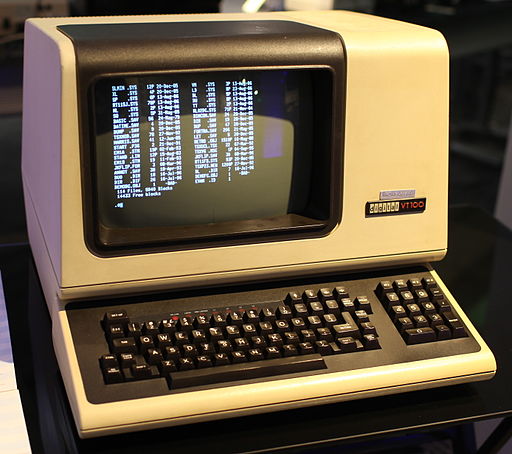Unit 3: Terminal and Shell
What is a Terminal?
With the advances in Cathode-ray tube (CRT), the teletype machine is replaced with computer terminals in the late 1970s. Instead of printing the output on paper, the output from CLI is now printed on a monitor supporting 24x80 characters on screen in black and white (or green).
In modern days, operating systems still use similar underlying
functionalities to read in keyboard inputs and print out text
to show to the users, but instead of these clunky special
purpose devices, the functionality of a terminal is replaced
by programs called terminal emulator or virtual terminal.
Examples include Terminal and iTerm2 on macOS; Windows Terminal
on Microsoft; xterm and konsole on Ubuntu, etc.
Many legacy control commands on these teletype machines remain
in today's computing environment, such as the terminal control
sequence.
What is a Shell?
The term CLI refers to a type of user interface. To realize this interface, Unix computing environments rely on another type of program called shell.
A shell usually works closely with a terminal to get inputs from the users, interpret the meaning of the inputs, execute the tasks (perhaps through the invocation of other programs), and returned the output back to the user through the terminal.
Note that a shell can run on its own without a terminal (it can read input from a file, and write the output to a file, for instance).
There are many shells available, each with different bells and whistles to help improve our productivity.
The most popular shell that comes as default on many Unix systems
is bash, or Bourne Again Shell. This is the shell that we will
use in this workshop and as default in the SoC Unix computing environment.
I (Wei Tsang) personally use fish for
my day-to-day work. Oh-my-zsh (zsh) is
another shell popular among experienced users.
Command Prompt
A shell has a command prompt. It typically looks something like this, but will be different depending on the default configuration on your machine:
ooiwt@pe111:~$
The prompt is where you type in a command for the shell to interpret and execute.
In bash, the command prompt can be customized to include information such as the username, hostname, time, current working directory, etc. It is customary to use the $ sign as the final character of the prompt. In our examples, we will just show $ to incidate the command prompt.
Depending on the habit, sometimes you are asked to type in a command "into the terminal", "into the shell", or "into bash". They all mean the same thing: type in the command at the command prompt of the shell.
Terminal Control Sequence
On the old teletype machines (see history of command-line interfaces), a user can send special commands to the teletype machines to control its operation. Many of these special commands still exists today, and can be triggered by with hitting a combination of Ctrl and another key (i.e., a control sequence).
The following lists some of the most useful control sequences to know:
Ctrl+D : signal the end of input to a program. This is also used to exit from a shell (by telling the shell that you have no more input to send and you are done with it).
Ctrl+Z
: suspend the current running program. This pauses the execution
of the program (but not terminating it). In the bash shell, the most recently suspended program can resume executing in the background with the command bg or brought back to execution in the foreground again with the command fg.
Ctrl+C : terminate the current running program.
Ctrl+S : freeze the terminal. This is a legacy control command that pauses the output printing of a teletype machine. You shouldn't need to use this control sequence.
Ctrl+Q : resume the terminal. This is a legacy control command that resume the printing of a teletype machine. You shouldn't need to use this control sequence, unless you accidentally hit Ctrl+S
Ctrl+Z vs. Ctrl+C
A common mistake for new students is to hit Ctrl+Z frequently if something goes wrong with their program -- this behavior leads to large number of suspended programs (which still occupy resources such as memory on the computer). The right sequence to use is Ctrl+C -- which terminates the program (and frees up the resources).
Ctrl+S accidents
Since Ctrl+S is used as the "save" shortcut in non-Unix environment, many students accidentally hit this control sequence, causing their terminal to freeze. Don't panic if this happens. Just hit Ctrl+Q and things will be back to normal.
